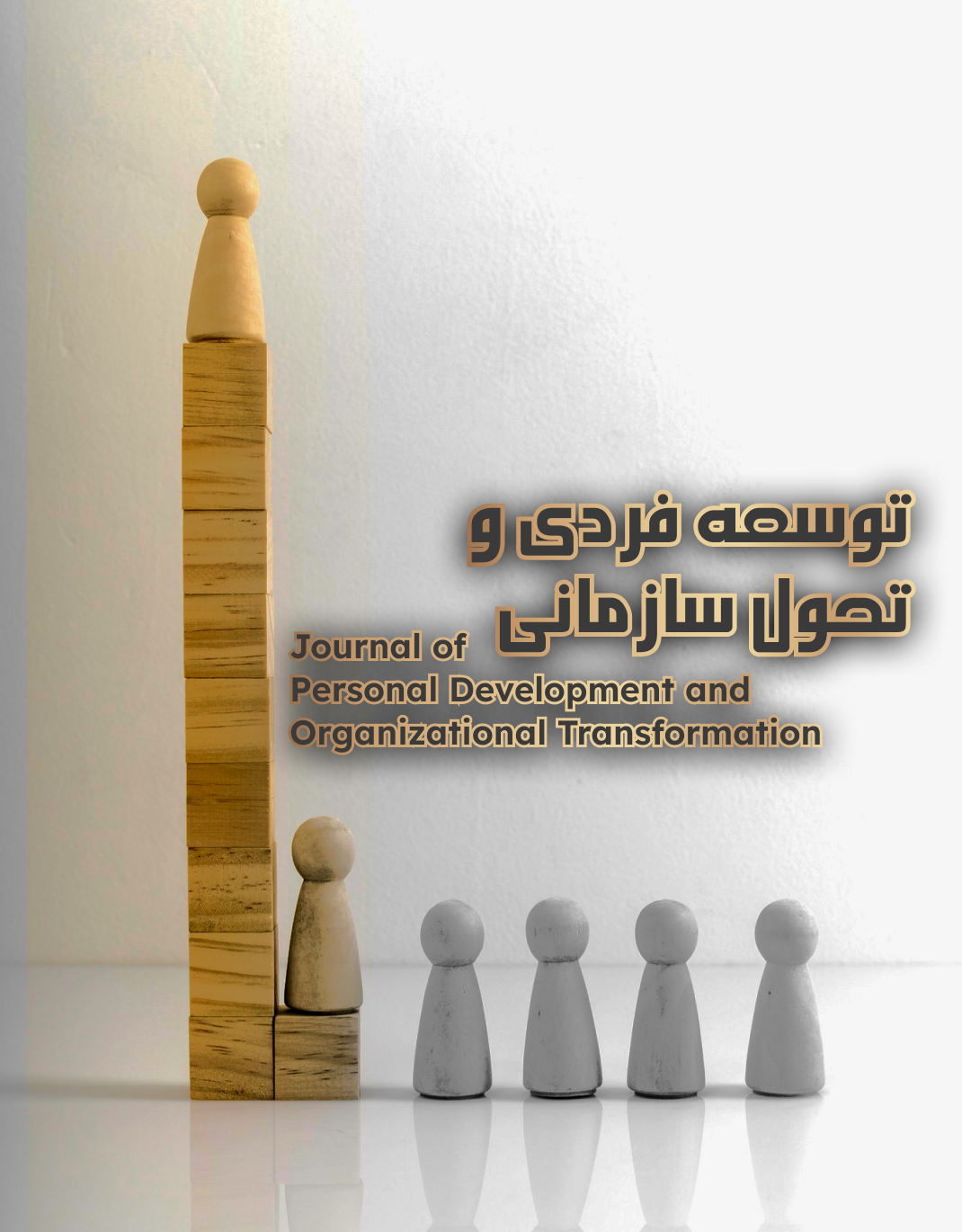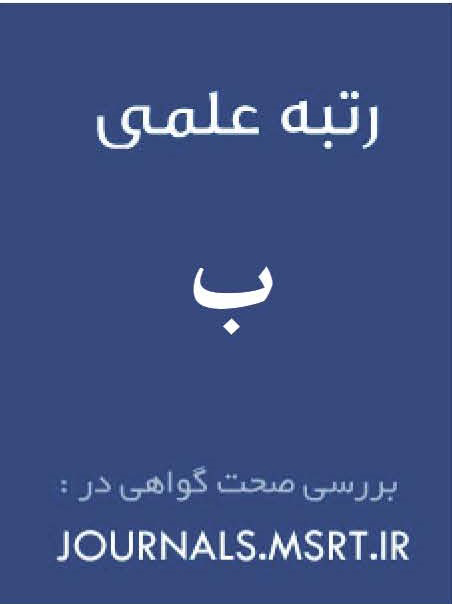فهم تجربهزیسته مدیران از مفهوم کارکنان نامرئی در سازمانهای دولتی: مطالعه موردی وزارت فرهنگ و ارشاد اسلامی
کلمات کلیدی:
کارکنان نامرئی, تجربهزیسته, کنارهگیری روانشناختی, حضورگرایی, وزارت فرهنگ و ارشاد اسلامیچکیده
هدف پژوهش حاضر، فهم عمیق تجربهزیسته مدیران از مفهوم کارکنان نامرئی در سازمانهای دولتی و تبیین ابعاد روانشناختی، ساختاری و فرهنگی این پدیده با تأکید بر وزارت فرهنگ و ارشاد اسلامی بود. این پژوهش با رویکرد کیفی و در چارچوب پارادایم تفسیری انجام شد. از روش پدیدارشناسی توصیفی کلایزی (1978) برای تحلیل دادهها استفاده گردید. مشارکتکنندگان شامل 14 نفر از مدیران سطوح مختلف وزارت فرهنگ و ارشاد اسلامی بودند که بهصورت هدفمند و بر اساس معیارهایی همچون سابقه مدیریتی، تجربه مستقیم و تنوع جایگاه انتخاب شدند. ابزار گردآوری دادهها مصاحبه نیمهساختاریافته بود و برای اعتبارسنجی یافتهها از معیارهای گوبا و لینکلن (1985) شامل باورپذیری، انتقالپذیری، اطمینانپذیری و تأییدپذیری استفاده شد. نتایج نشان داد که پدیده کارکنان نامرئی از دیدگاه مدیران، نوعی گسست میان حضور فیزیکی و درگیری ذهنی و عاطفی کارکنان است که در قالب انفعال عملکردی و رفتار اجتنابی بروز میکند. این وضعیت معمولاً در واکنش به عواملی چون بوروکراسی سنگین، ارتقای مبتنی بر سابقه، نبود مسیر شغلی شفاف و ضعف رهبری الهامبخش شکل میگیرد. پیامدهای آن در سه سطح مشاهده شد: در سطح سازمانی شامل مرگ خلاقیت و ازدسترفتن دانش ضمنی؛ در سطح گروهی شامل بیتفاوتی، فرسودگی و افت همکاری؛ و در سطح فردی شامل آسیب روانی، بحران معنا و احساس بیارزشی شغلی. پدیده کارکنان نامرئی، یک عارضه سازمانی عمیق است که ریشه در تعامل عوامل ساختاری، مدیریتی و فرهنگی دارد. مدیران راهحل را در ترکیب راهبردهای مدیریتی، سیستمی و فرهنگی برای گذار از مدیریت فرآیندگرا به رهبری انسانمحور میدانند. استقرار نظام شایستهسالاری، طراحی مسیرهای شغلی شفاف، ایجاد فرهنگ قدردانی و ارتقای امنیت روانی از جمله پیشنیازهای احیای تعلق و پویایی سازمانی است.
دانلودها
مراجع
Abdalla, B. A., & Mohamad, P. S. (2024). The Moderating Role of "Off-the-Job Embeddedness" in the relationship between "On-the-Job Embeddedness" And Procrastination at Work among Public University Employees: an analytical study. The Scientific Journal of Cihan University-Sulaimaniya, 8(1), 449-474. https://journal.sulicihan.edu.krd/index.php/sjcus/article/view/296
Afrahi, B., Blenkinsopp, J., de Arroyabe, J. C. F., & Karim, M. S. (2022). Work disengagement: A review of the literature. Human Resource Management Review, 32(2), 100822. https://doi.org/10.1016/j.hrmr.2021.100822
Akgunduz, Y., & Eryilmaz, G. (2018). Does turnover intention mediate the effects of job insecurity and co-worker support on social loafing? International Journal of Hospitality Management, 68, 41-49. https://doi.org/10.1016/j.ijhm.2017.09.010
Aydın, E. (2023). Does psychological contract breach lead to procrastination at work? The mediation function of organizational cynicism. Journal of Management and Economics Research, 21(1), 224-243. https://doi.org/10.11611/yead.1238902
Azizi, M., Filli, A., & Sabat, A. (2020). Examining the Role of Invisible Employees on Organizational Apathy with the Mediating Role of Job Flattening. Quarterly Journal of Business Management, 12(48), 75-93.
Da, L. H. (2017). Managing a lazy employee. The Journal of Medical Practice Management, 32(4), 265-274. https://search.proquest.com/openview/b07692e3c26279c452ef77aa94a8e84c/1?pq-origsite=gscholar&cbl=32264
De Clercq, D., Fatima, T., & Jahanzeb, S. (2022). Cronies, procrastinators, and leaders: A conservation of resources perspective on employees' responses to organizational cronyism. European Journal of work and organizational psychology, 31(1), 77-88. https://doi.org/10.1080/1359432X.2021.1928076
Deyhimpour, M. (2024). Invisible Employees and the Creation of Organizational Toxicity with the Moderating Role of Social Capital. Journal of Social Capital Management, 10(4), 411-425.
Fathi Chagheni, F. (2022). Organizational Cronyism and the Invisibility of Employees: Explaining the Mediating Role of Psychological Contract Breach in Public Organizations. Scientific Quarterly of Human Resource Management and Support Development, 17(64), 133-160.
Gibney, R., Zagenczyk, T. J., & Masters, M. F. (2009). The negative aspects of social exchange: An introduction to perceived organizational obstruction. Group & Organization Management, 34(6), 665-697. https://doi.org/10.1177/1059601109350987
Gostick, A., & Elton, C. (2006). The invisible employee: Realizing the hidden potential in everyone. John Wiley & Sons. https://books.google.com/books?hl=en&lr=&id=hG2ttqQa_RAC&oi=fnd&pg=PR7&dq=Gostick,+A.+and+C.+Elton+(2006).+The+invisible+employee:+Realizing+the+hidden+potential+in+everyone,+John+Wiley+%26+Sons.+%09&ots=tqLZkcGfXZ&sig=dpwJW2GP_bAMkYrJnrsuzt0GFNA
Gostick, A., & Elton, C. (2019). The invisible employee: Using carrots to see the hidden potential in everyone. John Wiley & Sons. https://books.google.com/books?hl=en&lr=&id=GYhJIKQM53EC&oi=fnd&pg=PT27&dq=Gostick,+A.+and+C.+Elton+(2019).+The+invisible+employee:+Using+carrots+to+see+the+hidden+potential+in+everyone,+John+Wiley+%26+Sons.+%09&ots=wHjt6qOY19&sig=ihRJ_P-t1fxp71bHXQGYJtbm2cw
Hasan, S. A., Naseem, A., Mahmood, M., Sajjad, Z., & Mirza, M. Z. (2024). Impact of supervisor phubbing on workplace incivility and workplace presenteeism: mediation and moderation effect of self-esteem and power distance. Journal of Management Development, 43(1), 68-86. https://doi.org/10.1108/JMD-08-2023-0230
Huang, Q., Zhang, K., Bodla, A. A., & Wang, Y. (2022). The influence of perceived red tape on public employees' procrastination: The conservation of resource theory perspective. International journal of environmental research and public health, 19(7), 4368. https://doi.org/10.3390/ijerph19074368
Kausar, F., Ijaz, M. U., Rasheed, M., Suhail, A., & Islam, U. (2024). Empowered, Accountable, and Committed? Applying self-determination theory to examine work-place procrastination. Research Square. https://doi.org/10.21203/rs.3.rs-4281333/v1
Lemon, L. L., & Tackett, T. (2025). The Work from Home (WFH) Employee Engagement Experience. Journal of Public Relations Research, 1-21. https://doi.org/10.1080/1062726X.2025.2455718
Li, Q., Jiang, P., She, Z., & Ma, L. (2024). Too depleted to work? A daily study on how work-related ICT use after hours influences employee next-day work procrastination behaviour. Work & Stress, 1-25. https://doi.org/10.1080/02678373.2024.2364601
Liu, M., Cheng, L., Wang, Y., Zeng, Q., & Zeng, Y. (2025). The Bidirectional Relationship Between Workplace Bullying and Presenteeism: A Systematic Review and Meta-Analysis. Workplace Health & Safety. https://doi.org/10.1177/21650799241302824
Manteghi, M. (2019). Examining the Behavioral Patterns of Invisible Employees in Organizations. Public Organization Management, 8(1), 125-140. https://ipom.journals.pnu.ac.ir/article_6360_en.html?lang=en
Masri, M., Ghafarzadeh, M., & Panahi, B. (2021). Investigating the Impact of Human Resource Leadership Agility on Reducing the Phenomenon of Invisible Employees with Knowledge Sharing as a Mediator. Management and Human Resource Development and Support, 16(59), 22-45. https://www.sid.ir/paper/965537/en
Maurya, M. A. K., & Mishra, M. K. A. (2025). A comparative analysis of sports achievement motivation among football, handball, and volleyball players of Lucknow University. International Journal of Engineering Technology Research & Management, 9(5), 1-5. https://ijobsms.org/index.php/ijobsms/article/view/413
Mousavi, S. N. a.-D., Sepahvand, R., & Fathi Chagheni, F. (2024). Organizational Cronyism and Procrastination: Analyzing the Preventive Effect of Social Capital in Public Organizations. Journal of Social Capital Management, 10(1), 31-45. https://journals.ut.ac.ir/article_86099.html
Mousavi, S. N. a.-D., Sepahvand, R., Mohammadiyari, Z., & Vahdati, H. (2020). The Role of Invisible Employees in Organizational Laziness in Public Organizations. Research in Human Resource Management, 10(1), 51-76. https://hrmj.ihu.ac.ir/m/:%20https:/hrmj.ihu.ac.ir/article_28850.html
Rastgarinia, Z. (2014). Invisible Employees: Reform and Training. Tehran: Noor Elm Publications.
Sadri Nia, M., Baqer Gorji, M., Azma, F., & Cheragali, M. R. (2022). Designing a Model for Employees' Mental Absence Using a Grounded Theory Approach in Municipalities. Public Organization Management, 10(2), 93-106. https://ipom.journals.pnu.ac.ir/article_8706.html
Salimi, N., Taban, M., Pourashraf, Y. A., & Viseh, S. M. (2021). Proposing a Model for Controlling Invisible Employees in Public Organizations (Case Study: Universities and Higher Education Institutions in Ilam City). Journal of Productivity Management, 15(58), 121-143. https://journals.iau.ir/article_684611.html
Sarria, M. Z. S. (2024). Understanding Work Procrastination: Causes, Impacts, and Management Strategies. SCT Proceedings in Interdisciplinary Insights And Innovations, 2, 245. https://doi.org/10.56294/piii2024245
Sharbatzadeh, R., Fouladi, J., Noori, M., & Navkhasi, J. (2022). Foresight of Human Resource Development in the Physical Education Organization of the Islamic Republic of Iran with a Structural Analysis Approach. Sports Science and Combat Readiness Quarterly, 2(3), 1-17.
Shariati Nejad, A., & Aini Nargesseh, Z. (2024). Identifying and Analyzing the Causes and Consequences of Presence Syndrome Using a Fuzzy Cognitive Mapping Approach. Public Organization Management, 12(2), 19-40.
Shayestahrad, A., & Chenari, V. (2022). Proposing a Model for Transforming Invisible Employees into Visible Ones in Iran's Public Sector. Quarterly Journal of Management Sciences Research, 4(11), 34-49.
Wang, H., & Zong, G. (2023). Relationship between employees' perceived illegitimate tasks and their work procrastination behavior: Role of negative emotions and paternalistic dimensions. Heliyon, 9(4), e15372. https://doi.org/10.1016/j.heliyon.2023.e14984
Yang, F., Luo, C., & Pan, L. (2024). Do digitalization and intellectual capital drive sustainable open innovation of natural resources sector? Evidence from China. Resources Policy, 88, 104345. https://doi.org/10.1016/j.resourpol.2023.104345
دانلود
چاپ شده
ارسال
بازنگری
پذیرش
شماره
نوع مقاله
مجوز
حق نشر 2025 Ahmadhosein Fataei (Author); Kumars Ahmadi; Fatemeh Sohrabi (Author)

این پروژه تحت مجوز بین المللی Creative Commons Attribution-NonCommercial 4.0 می باشد.






